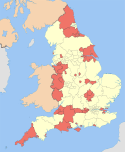City of York Council
City of York Council is the municipal governing body of the City of York, a unitary authority in Yorkshire, England. It is composed of 47 councillors, one, two, or three for each of the 21 electoral wards of York. It is responsible for all local government services in the City of York, except for services provided by York's town and parish councils.
City of York Council | |
|---|---|
| Whole council elected every four years | |
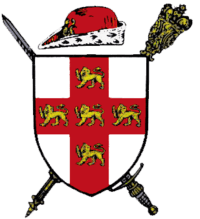 | |
 | |
| Type | |
| Type | |
| Leadership | |
Lord Mayor | |
Leader of the Opposition | |
| Structure | |
| Seats | 47 councillors |
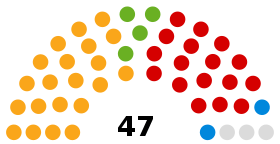 | |
Political groups |
|
Length of term | 4 years |
| Elections | |
| First past the post | |
Last election | 2 May 2019 |
Next election | 4 May 2023 |
| Meeting place | |
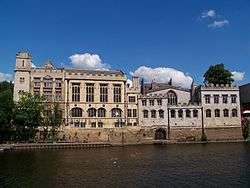 | |
| The Guildhall, York | |
| Website | |
| www | |
History
Municipal borough
The ancient liberty of the City of York was replaced in 1836 by a municipal borough, with city status, as a result of the Municipal Corporations Act 1835. As a municipal borough, the York Corporation was responsible for all local government services in the City of York. The municipal borough was expanded to serve the following areas:[1]
| Year | Area | Transferred from | Transferred to |
|---|---|---|---|
| 1836 | The City of York | - | City of York (municipal borough) |
| 1884 | The parish of Holgate and part of the parishes of Clifton, Dringhouses, Gate Fulford, Heworth, and Middlethorpe | ||
County borough
The municipal borough was replaced in 1884 by a county borough, with city status, as a result of the Municipal Corporations Act 1882. As a county borough, the York Corporation was responsible for all local government services in the City of York. When county councils were established for the East Riding, North Riding, and West Riding in 1889, as a result of the Local Government Act 1888, the City of York remained outside of their jurisdiction. The county borough was expanded and reduced in size to serve the following areas:[1]
| Year | Area | Transferred from | Transferred to |
|---|---|---|---|
| 1884 | The City of York | City of York (municipal borough) | City of York (county borough) |
| 1893 | Part of the parish of Clifton | - | |
| 1934 | Part of the parishes of Clifton Without, Heworth Without, Huntington, and Osbaldwick | Rural District of Flaxton | |
| 1937 | The parish of Middlethorpe Without and part of the parishes of Bishopthorpe and Dringhouses Without | Rural District of Bishopthorpe | |
| Part of the parishes of Acomb and Knapton | Rural District of Great Ouseburn | ||
| 1957 | Part of the parish of Askham Bryan | Rural District of Tadcaster | |
| 1968 | Part of the City of York | City of York (county borough) | Rural District of Flaxton |
| 1968 | Part of the parish of Heslington | Rural District of Derwent | City of York (county borough) |
| Part of the parish of Clifton Without | Rural District of Flaxton |
Non-metropolitan district
The county borough was replaced in 1974 by a non-metropolitan district, with city status, as a result of the Local Government Act 1972. As a non-metropolitan district, York City Council was responsible for some local government services in the City of York, with others being the responsibility of North Yorkshire County Council. The non-metropolitan district served the same area as the county borough:
| Year | Area | Transferred from | Transferred to |
|---|---|---|---|
| 1974 | The City of York | City of York (county borough) | City of York (non-metropolitan district) |
Unitary authority
The non-metropolitan district was replaced in 1996 by a unitary authority, with city status, as a result of the Local Government Act 1992. As a unitary authority, City of York Council is responsible for all local government services in the City of York, except for services provided by York's town and parish councils. The unitary authority serves the following areas:
| Year | Area | Transferred from | Transferred to |
|---|---|---|---|
| 1996 | The City of York | City of York (non-metropolitan district) | City of York (unitary authority) |
| The parishes of Hessay, Nether Poppleton, Rufforth, and Upper Poppleton | Borough of Harrogate | ||
| The parishes of Clifton Without, Earswick, Haxby, Heworth Without, Holtby, Huntington, Murton, New Earswick, Osbaldwick, Rawcliffe, Skelton, Stockton-on-the-Forest, Strensall, Towthorpe, and Wigginton | District of Ryedale | ||
| The parishes of Acaster Malbis, Askham Bryan, Askham Richard, Bishopthorpe, Copmanthorpe, Deighton, Dunnington, Elvington, Fulford, Heslington, Kexby, Naburn, and Wheldrake | District of Selby |
Political control
Since 1995 political control of the council has been held by the following parties:[2]
| Party in control | Years | Council leader |
|---|---|---|
| Labour | 1995 – 2003 | Cllr Rodney Hills, Cllr David Merrett |
| Liberal Democrats | 2003 – 2007 | Cllr Steven Galloway |
| No overall control | 2007 – 2011 | Cllr Andrew Waller |
| Labour | 2011 – 2015 | Cllr James Alexander, Cllr Dafydd Williams |
| No overall control | 2015 – 2019 | Cllr Chris Steward, Cllr David Carr, Cllr Ian Gillies, Cllr Keith Aspden |
| No overall control | 2019 - present | Cllr Keith Aspden |
2015-2019
Conservatives and Liberal Democrats 26 of the 47 seats formed a joint administration to run the council in May 2015. Both parties are opposed to green belt development on the scale proposed by the Labour Party.[3] The working majority of the joint administration shrunk in February 2018 to 24 seats, when former council leader Cllr David Carr (Copmanthorpe Ward) and Cllr Suzie Mercer (Wheldrake Ward) quit the Conservative group and party,[4] Labour councillors Fiona Derbyshire and Hilary Shepherd resigned from the Labour Party in August to sit as Independent Socialists York.[5]
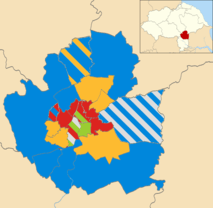
2019-present
Due to no overall control, the Liberal Democrats and the Green Party, who hold 25 of the 47 seats between them, joined forces to form a coalition to run the City of York Council, revealed by YorkMix on 14 May 2019. Support for the Liberal Democrats and Green Party in York increased at the poll. Both parties combined received more than 50% of the vote. Furthermore, the two parties are opposed to Brexit.[6]
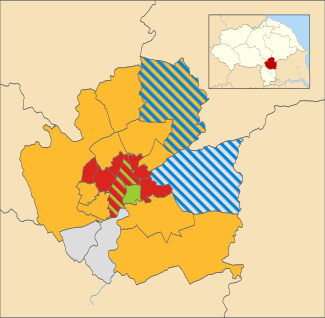
Lender option borrower option loans
The council has two lender option borrower option loans (LOBOs) worth £5 million. Each run until 2060 and 2077, with current interest rates of 3.66 percent and 3.8 percent. One of the loans was taken out in 2008, on a 69-year term, and the other in 2010, on a 50-year term.[7]
References
- Tillott, PM, ed. (1961). "The boundaries of the City". A History of the County of York: the City of York. Victoria County History. London: Victoria County History. pp. 311–321.
- "English local elections 2007 - York". BBC News. 4 May 2007. Retrieved 23 September 2009.
- "Tories & Lib Dems to run York - Chris Steward to be leader - Labour ousted - First policies revealed". York Press. Newsquest Yorkshire & North-East. 18 May 2015. Retrieved 19 May 2015.
- "Council in chaos as outgoing leader quits Tories over 'act of betrayal' - but council tax set". York Press. Newsquest Yorkshire & North-East. 22 February 2018. Retrieved 15 May 2018.
- "Two councillors quit Labour but continue as Independent Socialists York". York Press. Newsquest Yorkshire & North-East. 7 August 2018. Retrieved 4 October 2018.
- "Lib Dems and the Green Party join forces to run City of York Council". YorkMix. 14 May 2019. Retrieved 16 May 2019.
- Victoria Prest (14 July 2015). "City defends long-term loans, amid national controversy". York Press. Newsquest Yorkshire & North-East.
